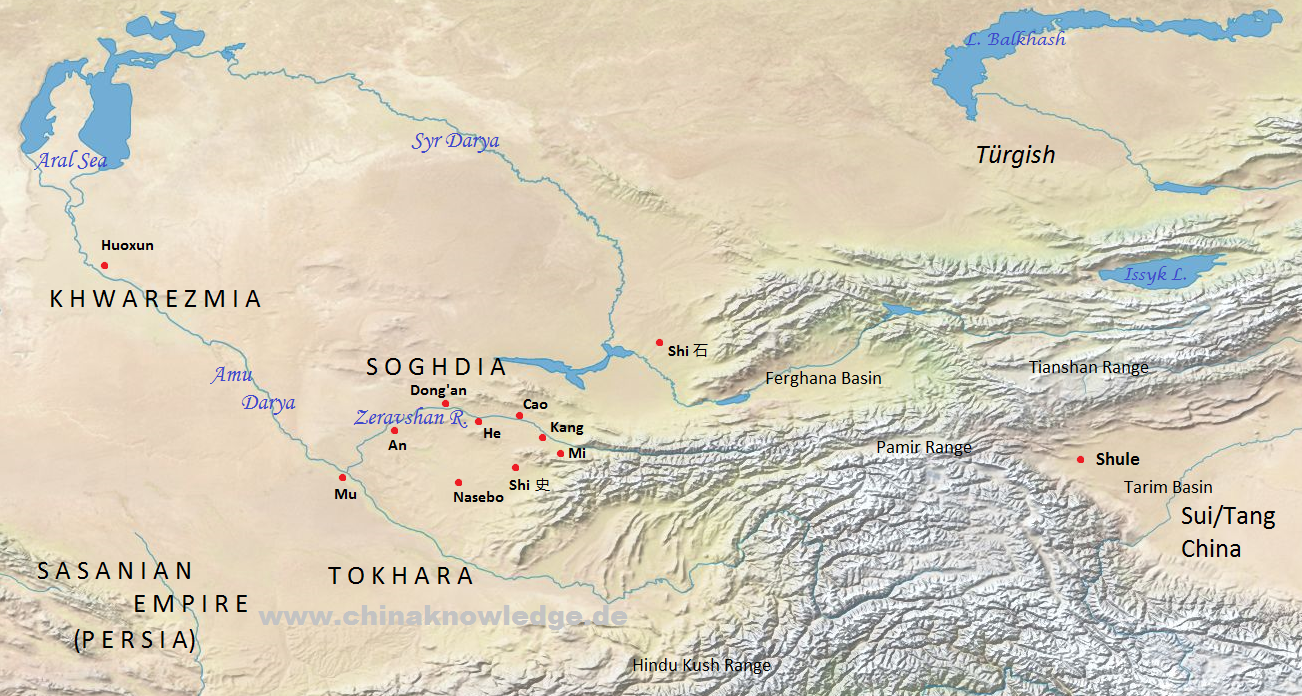The Nine Tribes of Zhaowu (Zhaowu jiuxing 昭武九姓), also called the "nine barbarian families" (jiuxing hu 九姓胡) founded several smaller or greater states in the region of Soghdia (also called the Soghdiana, by the Greeks known as Transoxania). These were known as the "many states of the Zhaowu [tribes]" (Zhaowu zhuguo 昭武諸國). It was traditionally believed that the nine tribes had migrated westwards after leaving their home city Zhaowu 昭武 at the foot of Mt. Qilian 祁連山 (today's Linze 臨澤 close to Zhangye 張掖, Gansu). Their home place was thus located in the western parts of the Han empire 漢 (206 BCE-220 CE). They evaded this place after being defeated by the steppe federation of the Xiongnu 匈奴.
Arrived in the plain of the rivers Amu Darya and Syr Darya, they founded the cities or states of Kangguo 康國, Anguo 安國, Caoguo 曹國, Miguo 米國, Heguo 何國, Shiguo 石國, Shiguo 史國, Wudi 戊地, and Huoxun 火尋. The last two were quite unimportant during the 6th and 7th centuries, but Huoxun (i.e. Khwarezmia) emerged as a dominant state in Central Asia in the 11th century. The political heads ("kings") of these states bore the family name Zhaowu 昭武.
 |
The Soghdia around 600 CE. Based on Tan Qixiang 譚其驤, ed. (1995), Zhongguo lishi ditu ji 中國歷史地圖集, Vol. 5, Sui, Tang, Wudai Shiguo shiqi 隋唐五代十國時期 (Beijing: Zhongguo ditu chubanshe, 1996). |
The origin of the designation Zhaowu is not fully clear. While the story of the migration from China to the West is not at all probable, the word [dʐɑʊ̯ωu] might be derived form the Iranian word siyāwūš, which means something like "hero", or javugasa, a similar word that is found on Tokharian coins, or the Türkic words shāba or yabgu, which denote persons in leading positions.
The inhabitants of Soghdia were famous merchants who also carried out their business along the Silkroad and in the imperial capital of China, early in the Later Han Dynasty capital of Luoyang 洛陽 (today in Henan), and during the Northern Dynasties period 北朝 (386~581) in Chang'an 長安 (today's Xi'an 西安, Shaanxi). Large merchant communities of Soghdians were also found in Lantian 藍田 and many cities throughout the western parts of China (wu bu zhi 無不至 "they went everywhere", Zhou and Ding, 2006). Some of them counted more than 3,000 families (Zhang 1993). Chinese sources also call them Jiuxing shanghu 九姓商胡 "merchant barbarians of the nine tribes". During the Tang period 唐 (618-907), Soghdian merchants used to cooperate with Uyghurs, which had a special right of residence in the capital. Quite of few of them lived in Chang'an for generations, and even bought real estate. Quite naturally, Soghdian communities also organized their own graveyards , of which some were excavated in the past decades. Soghdian merchants used their own coins, some of which were discovered in China.
The people in Soghia were also famous for their music and astronomical expertise. The religious spectrum was remarkable. It included Buddhism, Zoroastrianism, and Manicheism, and from the 8th century on, also Islam. Outside of the cities, Soghdians engaged in agriculture, and some in pastoral nomadism. In some places, people bred horses.
Ethnically, it is quite sure the the Soghdians were Indo-Europeans, at least according to the description of their physical appearance described in Chinese sources. They spoke Soghdian, an Eastern Iranian language (Suteyu 粟特語), and wrote in Soghdian script (Sutewen 粟特文, Suliwen 窣利文), which was derived from the Syriac script.
 |
Soghdian version of the Sutra "The Buddha preaches on the causality of good and evil deeds" (Fo shuo shan'e yinguo jing 佛說善惡因果經), Source: Ji (1988). |
Of all states, Kangguo was the strongest. Soghdia was during the 5th century century nevertheless dominated by the Hephthalites (Yeda 嚈噠), and later by the khanate of the Western Türks. In the mid-7th century the Tang empire conquered the Western Region and created the Protectorate of the Pacified West (anxi duhufu 安西都護府), with the area commands (dudufu 都督府) Kangju 康居 and Dawan 大宛, and indirectly administered prefectures (jimizhou 羈縻州) like Guishuang 貴霜 or Anxi 安息.
In 751, Tang China lost the Soghdiana to Muslim invaders.